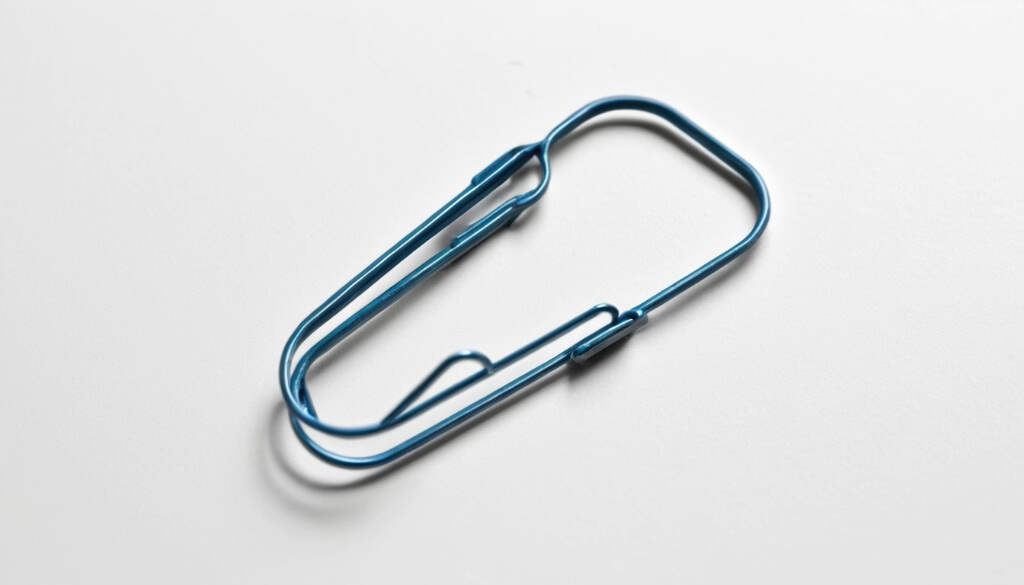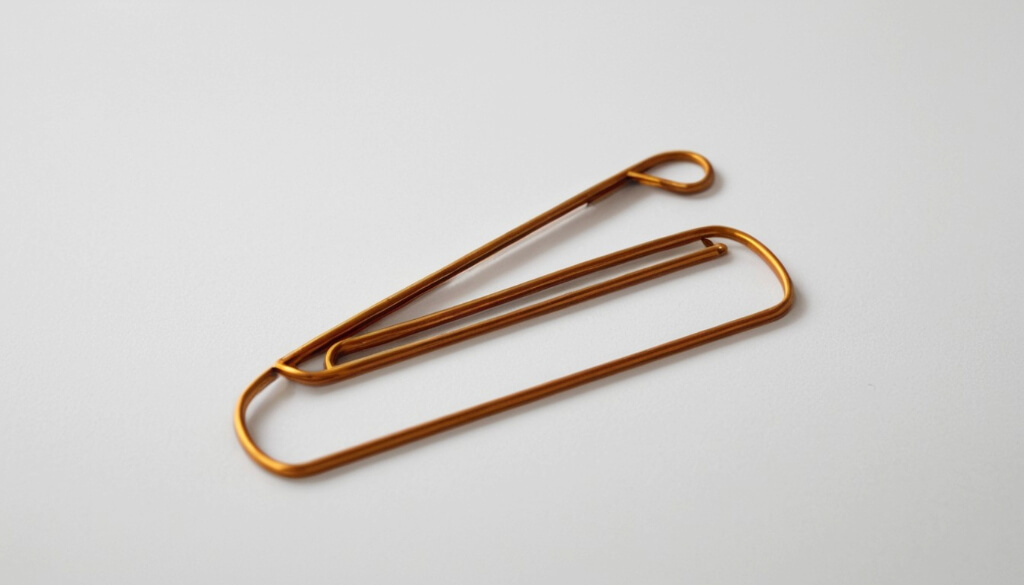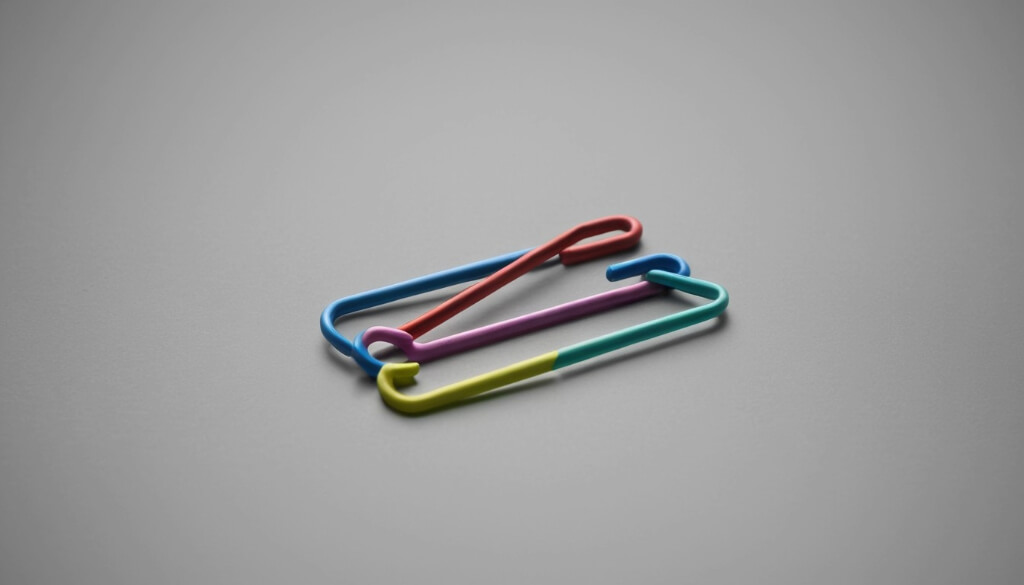In the realm of office supplies, few items are as ubiquitous and indispensable as the paperclip. Found in offices, schools, and homes worldwide, this humble yet essential tool serves the simple purpose of binding papers together. Yet, behind its everyday utility lies a fascinating history shrouded in mystery. Who invented the paperclip? This question has sparked curiosity and debate among historians and enthusiasts alike, leading to a journey through time to uncover the truth.

The Predecessors Of The Paperclip
Before the paperclip emerged as a staple in office environments worldwide, people relied on a variety of methods to bind papers together. These methods were often makeshift solutions, utilizing materials readily available at the time.
Ribbons and pins were among the earliest tools used to hold papers together. While effective to some extent, they were not particularly practical for everyday use, especially when dealing with large volumes of documents. Pins posed the risk of damaging papers or pricking fingers, while ribbons could easily become tangled or untied, leading to disorganized piles of papers.
Wax seals were another common method of fastening documents, particularly in official correspondence and legal matters. However, their use was largely limited to sealing envelopes rather than binding individual sheets of paper together. Similarly, string or twine could be wrapped around bundles of paper, but this method lacked the convenience and reusability of modern paper fasteners.
As the need for a more efficient solution became apparent, inventors and innovators began experimenting with new designs and materials. These early pioneers laid the groundwork for the invention of the paperclip, recognizing the importance of creating a simple yet effective tool for organizing papers.
The transition from these rudimentary methods to the invention of the paperclip marked a significant advancement in the field of office supplies. With its streamlined design and ease of use, the paperclip revolutionized the way people managed and organized their documents, setting the stage for the modern era of paper management.
The First Patents
The quest to uncover who invented the paperclip leads us back to the 19th century when the first documented patents related to paper fasteners emerged. These early patents represent the initial steps in the development of the modern paperclip and provide valuable insights into the evolution of paper management tools.
One of the earliest patents related to paper fasteners was granted to the American inventor Samuel B. Fay in 1867. Fay’s patent, titled “Improvement in Paper Clips,” described a device consisting of a bent wire that could be used to fasten papers together. While Fay’s design differed from the familiar double-looped shape of the modern paperclip, it laid the foundation for subsequent innovations in paper-fastening technology.
Fay’s patent demonstrated a recognition of the need for a simple and practical solution to the problem of paper organization. His invention offered an alternative to more cumbersome methods of paper binding, such as ribbons and pins, and provided a convenient way to keep documents organized and secure.
Following Fay’s patent, other inventors began to explore similar ideas for paper fasteners. These early designs varied in their construction and functionality but shared a common goal of improving the efficiency of paper management. While many of these early patents did not achieve widespread recognition or commercial success, they played a crucial role in advancing the field of paper-fastening technology.
One of the key challenges faced by early inventors was the need to strike a balance between simplicity and effectiveness in their designs. The ideal paper fastener needed to be easy to use, durable, and capable of securely holding papers together without causing damage. Achieving this balance required careful experimentation and refinement, as inventors sought to perfect their designs.
The emergence of patents related to paper fasteners marked a significant milestone in the history of office supplies. These early inventions paved the way for subsequent innovations, including the iconic double-looped paperclip patented by Johann Vaaler in 1899. While Fay and Vaaler are often credited with inventing the paperclip, their contributions were part of a larger continuum of experimentation and invention that spanned decades.
The first patents related to paper fasteners represent the initial stages of a journey that would ultimately lead to the invention of the modern paperclip. These early inventions laid the groundwork for subsequent innovations, demonstrating the power of human ingenuity to solve everyday problems with elegant solutions.
The Innovators In The 19th Century
During the 19th century, amid the backdrop of industrialization and burgeoning bureaucracy, several inventors emerged with designs for paper fasteners that would pave the way for the modern paperclip. Among these innovators, two figures stand out: Samuel B. Fay and Johann Vaaler.

Samuel B. Fay, an American lawyer and inventor, made significant contributions to the development of paper fasteners in the mid-19th century. In 1867, Fay received the first known patent for a bent-wire paper fastener, marking a crucial step forward in the evolution of the paperclip. His designs, though rudimentary compared to later iterations, demonstrated a fundamental understanding of the need for a simple and practical solution to the problem of paper organization.
However, it was Johann Vaaler, a Norwegian inventor, who would later become synonymous with the paperclip. In 1899, Vaaler submitted a patent application for his “paper clip” design, which featured a double-looped wire construction similar to the modern paperclip. While Vaaler’s patent was initially overlooked and never achieved commercial success during his lifetime, his contribution to the development of the paperclip was later recognized as significant.
The designs of Fay and Vaaler represent key milestones in the evolution of the paperclip. Fay’s early patents laid the groundwork for subsequent innovations, demonstrating the feasibility of using bent wire as a fastening mechanism for papers. Meanwhile, Vaaler’s design refined and standardized the concept, establishing the iconic double-looped shape that would become synonymous with the paperclip.
Despite their contributions, both Fay and Vaaler faced challenges in popularizing their inventions. Fay’s paper fasteners struggled to gain widespread adoption, while Vaaler’s patent went largely unnoticed during his lifetime. It was only in the decades following their respective patents that the paperclip began to gain traction as an essential office supply.
The legacy of Fay and Vaaler lives on in the modern paperclip, a testament to their ingenuity and foresight. While the question of who invented the paperclip may never have a definitive answer, the contributions of these two innovators cannot be overstated. Their designs laid the foundation for a ubiquitous and indispensable tool that continues to shape the way we organize and manage documents in the digital age.
The Controversy Surrounding The Invention
The history of the paperclip is not without its controversies and debates, particularly concerning the identity of its true inventor. While Johann Vaaler is often credited with inventing the modern paperclip, the story is far from straightforward, and conflicting claims have led to ongoing speculation and controversy.
One of the primary sources of contention is the role of Samuel B. Fay, an American inventor who received a patent for a paper fastener in 1867. Fay’s designs, though different from the modern paperclip, bear similarities in their basic functionality. Some historians argue that Fay’s early patents laid the groundwork for later innovations, including Vaaler’s double-looped design. However, others maintain that Fay’s inventions were distinct from the paperclip and should not be considered in the same context.
Adding to the complexity is the fact that Vaaler’s patent for the paperclip, filed in 1899, did not achieve widespread recognition during his lifetime. The design was not heavily promoted or commercialized, and as a result, Vaaler’s contributions to the invention of the paperclip were largely overlooked for many years. It wasn’t until the early 20th century, when other inventors began producing similar designs and commercializing them on a larger scale, that Vaaler’s role gained attention.
Furthermore, historical records are often sparse and incomplete, leaving room for interpretation and speculation. Some accounts suggest that Vaaler’s design was independently conceived, while others speculate that he may have been influenced by earlier patents or designs. Without definitive evidence to settle the matter, the question of who truly invented the paperclip remains open to interpretation.
Despite the controversy, one thing is clear: the paperclip has become an enduring symbol of simplicity and utility, transcending its origins to become an indispensable tool in offices and households worldwide. Whether attributed to Fay, Vaaler, or others, the invention of the paperclip represents a pivotal moment in the history of office supplies, demonstrating the power of human ingenuity to solve everyday problems with elegant solutions.
Global Adaptation And Commercialization
The invention of the paperclip marked the beginning of its journey from a simple office tool to a global icon of organization and efficiency. As the demand for paper management solutions grew, so too did the paperclip’s popularity, leading to its widespread adaptation and commercialization on a global scale.
Initially patented by Johann Vaaler in Norway in 1899, the paperclip’s design quickly caught the attention of manufacturers and entrepreneurs around the world. Recognizing its potential to streamline paper organization, companies began producing paperclips in various shapes, sizes, and materials to cater to diverse needs and preferences.
One of the key factors driving the paperclip’s global adaptation was its simplicity and affordability. Unlike other paper fastening methods of the time, such as pins or ribbons, the paperclip offered a convenient and reusable solution that required minimal effort to use. Its low production cost and ease of manufacture made it accessible to a wide range of consumers, from large corporations to individual users.
As manufacturing techniques improved and distribution networks expanded, the paperclip quickly became a staple in offices, schools, and households worldwide. Its versatility and reliability made it indispensable for organizing documents, and holding together everything from memos and reports to personal correspondence and homework assignments.
The commercialization of the paperclip also played a significant role in its global adoption. Manufacturers invested in advertising and marketing campaigns to promote their paperclip brands, emphasizing their durability, functionality, and value for money. The iconic shape of the paperclip became synonymous with efficiency and order, making it instantly recognizable to consumers everywhere.
Beyond its practical utility, the paperclip also gained cultural significance in various societies around the world. In some cultures, it symbolizes unity and solidarity, representing the idea of holding things together in times of adversity. Artists and designers have incorporated the paperclip into their work as a symbol of creativity and resourcefulness, using it to create sculptures, jewelry, and other works of art.
Today, the paperclip continues to be an essential tool for organizing papers and documents in offices, schools, and homes across the globe. Its enduring popularity speaks to the timeless appeal of simple, yet effective solutions to everyday problems. Whether used to bind papers or unleash artistic imagination, the paperclip remains a testament to human ingenuity and innovation.

Evolution Of The Paperclip
The evolution of the paperclip is a testament to human creativity and ingenuity, reflecting both advances in manufacturing technology and changing preferences in design. From its humble beginnings as a simple bent wire to its modern incarnations in various shapes and materials, the paperclip has undergone a remarkable transformation over the years.
Early Designs And Materials
The earliest paperclips were typically made from bent wire, a material that was readily available and easy to manipulate. These early designs were often simple in construction, consisting of a single loop or bend that could hold a small stack of papers together. While functional, these early paperclips lacked the durability and efficiency of later iterations.
Standardization And Mass Production
As the demand for paperclips grew, manufacturers began to standardize their designs and invest in mass production techniques. This led to the emergence of the iconic double-looped shape that we commonly associate with the paperclip today. Standardization allowed for greater production efficiency and ensured consistency in performance across different brands and manufacturers.
Technological Advancements
Advancements in manufacturing technology have also played a significant role in the evolution of the paperclip. Improved machinery and processes have made it possible to produce paperclips in larger quantities and with greater precision than ever before. This has led to a proliferation of paperclip designs, including variations in size, shape, and material.
Materials Innovation
While traditional paperclips were made from metal wire, modern iterations have expanded to include a wide range of materials. Plastic, rubber, and even wood are now used to manufacture paperclips, offering consumers a greater variety of options to suit their preferences and needs. These alternative materials also provide opportunities for customization and creativity in design.
Contemporary Uses
In addition to their traditional role in binding papers together, paperclips have found new and unexpected uses in the digital age. From cable management to DIY projects, paperclips have become versatile tools with applications beyond the office environment. Artists and designers have also embraced the paperclip as a medium for creative expression, incorporating it into sculptures, jewelry, and other works of art.
Environmental Considerations
As concerns about sustainability and environmental impact grow, manufacturers are exploring eco-friendly alternatives to traditional paperclip materials. Biodegradable plastics, recycled metals, and other sustainable materials are being developed to reduce the environmental footprint of paperclip production. Additionally, efforts are being made to promote the reuse and recycling of paper clips to minimize waste.
The evolution of the paperclip is a fascinating journey that spans centuries of innovation and adaptation. From its humble origins as a bent wire to its modern incarnations in various shapes and materials, the paperclip continues to be an essential tool for organizing papers and unleashing creative potential. As technology advances and societal needs evolve, the paperclip will undoubtedly continue to evolve and adapt to meet the challenges of the future.
Final Thoughts
The question of who invented the paperclip may never have a definitive answer. However, by exploring the contributions of inventors like Samuel B. Fay and Johann Vaaler, we gain insight into the fascinating history of this everyday object. The paperclip’s enduring legacy serves as a reminder of the ingenuity and creativity of those who sought to solve a simple yet essential problem in the world of paper management.
FAQs
Who Is Credited With Inventing The Paperclip?
While Johann Vaaler is often credited with inventing the modern paperclip, earlier designs by Samuel B. Fay and others also contributed to its development.
When Was The Paperclip Invented?
The paperclip as we know it today was patented by Johann Vaaler in 1899, although earlier designs for paper fasteners date back to the 19th century.
What Materials Are Paper Clips Made From?
Paperclips are typically made from metal wire, though variations in materials such as plastic and even wood can be found for specialized applications.
What Is The Purpose Of A Paperclip?
The primary purpose of a paperclip is to bind papers together, making them easier to organize and handle. However, paperclips also have various secondary uses, including as makeshift tools and artistic mediums.
Also Read: Thomas Edison’s Top Inventions That Transformed The World
